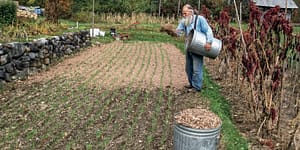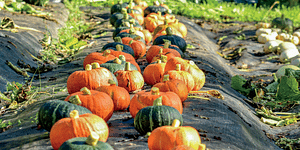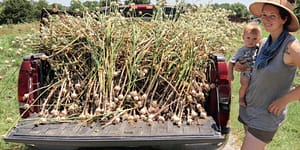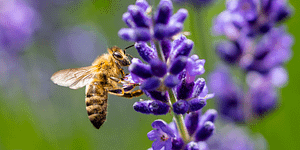Can’t Find the Perfect Garden Tools? Make Your Own

Is hoeing hurting your back? Is your trowel cramping your wrist? Are the tools at your local hardware store just not cutting it?
Gardening can be such laborious work, but what you put into your garden is what you get back. With a few simple do-it-yourself modifications you can find and alter your tools to suit your individual needs. Put your tools to work for you and watch your garden grow!
The following is an excerpt from The Winter Harvest Handbook: by Eliot Coleman. It has been adapted for the Web.
The garden tools in a hardware store are mass-market items. The shapes and sizes available are limited in order to minimize costs and maximize profits—ease of use is not the goal.
Years ago when farm and garden tools were used by professionals as well as by amateurs, the choices were far broader and tool designs were based on efficient use rather than marketing.
A look through old tool catalogs or the collection in a historical museum will give you some idea. Nuances abounded. Shovel catalogs offered all conceivable blade sizes, shapes, and angles. Regional peculiarities were acknowledged.
I have an old tool book with pictures of dozens of English hedging knives (billhooks).
Each slight variation in design is named after the town or county where it evolved. They were the distillation of centuries of local experience in cutting the different varieties of hedge plants common to different climates and different soils.
This functional diversity still exists on small farms in Europe.
For example, over many years I have taken photos of different styles of wheelbarrow. Whether single or double wheeled, wide or narrow, decked or open, there was no single perfect design, but rather many aspirations to perfection.
In addition, the farmers had added cuts or bends or welds to the standard models to fit them even more precisely to their needs. It was like looking at an author’s drafts or an artist’s sketches—a study in the creation and evolution of an idea.
The bricklayer’s trowel on the right has been modified into the transplant trowel on the left by cutting off the tip of the blade and lowering the angle of the handle.
Those who engage in sports encounter similar distinctions and refinements every day.
Enormous amounts of time, money, thought, and ingenuity go into perfecting sports “tools” such as golf clubs, tennis rackets, and skis.
Think what a difference graphite shafts, larger sweet spots, and metal laminates have made. How often in your farming endeavors have you wondered whether things would work better if the equipment were modified in a certain way.
Although there seems to be an appreciation for quality workmanship in farm and garden tools there does not seem to be a market for the nuances of perfection as in sports.
The answer to that is to be your own innovator.
Modifying existing tools or inventing your own is not complicated. Inventing doesn’t have to mean factories and engineering degrees, just imagination and ingenuity. Creativity means escaping from the traditional patterns in order to see things differently.
You can accomplish wonders with a hacksaw, a file, a drill, a pair of pliers, and a vise. Stop considering the tool you have as a finished product rather, consider it as a point of departure.
A good example was our desire, years ago, to improve the hoes on our farm.
Although most hoes we owned had a large blade at a 90-degree angle to the handle, there were a few with smaller blades at an 80-degree angle, and they were somewhat more pleasant to use.
Off to the workbench we went with a couple of sacrificial hoes and proceeded to cut, bend, and file. After repeated trips back to the fields to try them out we came up with a prototype with a narrow blade (7 inches side to side and 1 inch front to back) and with the neck bent to hold the cutting edge of the blade in line with the handle at a 75-degree angle.
After further experimentation with many eager participants we determined that the optimum angle was 70 degrees.
We also determined that a draw hoe of this style cut weeds best when sharpened like a chisel with the sharp edge next to the soil.
We now sharpen our hoes by holding them with the handle upright and filing across the upper edge of the blade.
I am fascinated by the great improvement in tool performance that can result from such seemingly small refinements. Since the edge of the blade was in line with the handle we called it the “collineal” hoe.
Another tool innovation in our market garden came as a result of changing our transplant system years ago.
When we started using soil-block-grown seedlings rather than bare-root plants, we found ourselves holding the transplant trowel in an uncomfortable position.
So we made a new tool.
We modified a sturdy bricklayer’s trowel by shortening the blade and changing the angle of the handle to parallel the blade, thus creating a tool that was comfortable to hold blade-down for jabbing and pulling rather than digging and made a perfect hole for inserting a soil block.
Tool modifications used to be common practice. Many have been forgotten. For example, a newly purchased scythe blade has a standard angle between blade and tang. When scythes were commonly used, everyone understood that it was up to them to bend that angle to fit their mowing style.
Another example is that store-bought tools usually come with one length of handle. Is it logical to assume the same handle length will be ideal for tool users from 5’4″ to 6’4″? Don’t struggle with a handle that is too long or too short—either cut it off or look for a longer one.
While you are looking at handle length also check out the type of wood and the grain.
The preferred woods for tool handles have traditionally been ash for long handles like hoe and shovel and hickory for short handles like axe and maul. The grain can be seen in all those little lines running down the handle.
Ideally the lines of grain should run straight from one end of the handle to the other. If the grain lines run at an angle across the handle, the stress of tool use will most likely initiate a break at that point.
Once you find a good handle you will want to keep it in shape by coating twice a year with a pure linseed oil or beeswaxlinseed mixture. That treatment keeps it from drying out.
Dry wood loses its liveliness, becomes brittle, and is more likely to fail.
Often the handle length on old tools had another purpose besides matching the height of the worker. Back when hay was collected loose, long-handled hayforks were used for pitching hay up on to the wagon.
A second worker on the wagon used a shorter fork to make the load stable. Exchange those tools and both workers would have been awkward and inefficient. That long-handled fork was the true “pitch fork.”
Today pitchfork has become the common name for most tool forks. However, they are functionally very different. Simply learning by name alone that there are hayforks and manure forks and spading forks and garden forks will help you come closer to finding the right tool for the job.
I want to encourage all growers to look beyond the tools that are readily available.
Make your farmwork easier and more pleasant by searching out unique tools or creating your own. There are lots of other growers out there looking to pioneer new systems and new crops who can benefit from your ideas and who can in turn inspire you with theirs.
We need to invent the future of small farming by ourselves to make all of us more efficient.
Recommended Reads
Recent Articles
If you’re a fan of cider, you know that the type of apple used can make or break the flavor. And with all the different brands of cider out there, many kinds of apples from across the world are being utilized to create it. In his new book Cider Planet, author and renowned cider maker…
Read MoreThe leaves are falling, which means it’s time start figuring out what to do with them. This year, try turning your fallen leaves into mulch for your garden!
Read MoreProper storage is crucial to ensuring that your produce stays fresh & retains nutritional value. Use these tips to prepare your harvest for long-term storage.
Read MoreAll hail the mighty garlic clove! Become a master at garlic growing with these simple tips for growing no-till garlic from seed to harvest.
Read MoreTired of trying different traditional medicines to relieve inflammation and joint pain? We have the perfect solution: honey bee venom.
Read More









